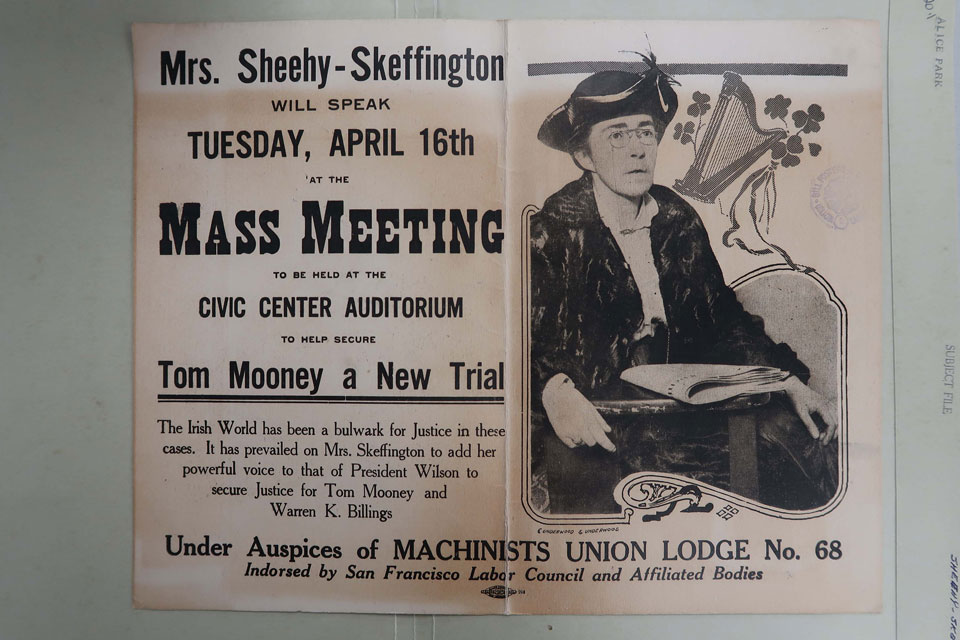
Margaret Ward’s groundbreaking 1983 book on revolutionary women in Ireland, Unmanageable Revolutionaries: Women and Irish Nationalism, 1880-1980, was republished in an updated, revised, and richly illustrated new edition by Arlen House in late 2021. It is a superb introduction to some of the great women in Irish history since Anna Parnell and an excellent detailed biography of women’s movements in Ireland. It provides readers with well-informed portraits of Anna Parnell, Constance Markiewicz, Maud Gonne, Hanna Sheehy-Skeffington, and others. It gives a detailed historical context for the work of The Ladies’ Land League, Inghinidhe na Éireann, and Cumann na mBan, and fleshes out, among many further things, the significant and later airbrushed participation of women during the Easter Rising.
Ward sheds light on women’s participation in the First and Second Dáil and highlights their political stance in that body. For example, interestingly, all six women in the Second Dáil opposed the Anglo-Irish Treaty, as did Cumann na mBan. Muriel MacSwiney, Linda Kearns, and Kathleen Barry stayed on the front lines in the Battle of Dublin after all other women combatants were sent home.
Ward points out that only Constance Markiewicz, as Minister for Labour, along with Liam Mellows spoke for working-class interest. Connolly’s words in the Easter Proclamation that an Irish Republic would guarantee “equal rights and equal opportunities to all its citizens” was important to the women in struggle and often quoted by them. In this context, it is regrettable that Connolly’s and Francis Sheehy Skeffington’s complete understanding of the need for women’s emancipation as integral to the liberation movement is not highlighted a little more in the book.

Ward shows the Irish women’s movement as aware of international developments, especially in relation to the USSR. She points out that Constance Markiewicz was (apart from royalty) “the second woman in the world to enter government, following Alexandra Kollontai in the Soviet Union.” She also states, “De Valera was once again elected President of the Irish Republic and Countess Markievicz reappointed Minister for Labour, but this time her position did not carry cabinet status. Both she and the labour movement were effectively demoted.” Ward also details the progressive betrayal of women in the Irish constitutions, and readers will not grow fonder of Éamon de Valera in this regard.
Although the main focus of the book is on the more famous women, Ward has done a magnificent job in reclaiming the names of the lesser known, indeed unknown activists, such as Eithne Coyle, for example, or Mary Colum. The author addresses this difficulty in her Introduction, “Unmanageable Revolutionaries Revisited,” where she details how more recently available archives, sources, and indeed the Internet have opened up new possibilities for research, such as the opening of the Bureau of Military History archives in 2003, access to information relating to applications made for military pensions (1619 made by women) and for service medals (4612 made by women). These figures alone demonstrate the significant number of women involved in the struggle for Irish freedom.
Research into these women has fallen to more recent historians, especially now that working-class history is beginning to become an acceptable field of exploration in universities. In this context, it would also be of interest to know if any research has been done into the Gaeltacht women’s involvement in the struggle. These women have been even more marginalized in mainstream history than their English-speaking counterparts.
The left-wing political group Saor Éire, open to both genders, on the other hand, is given attention in this book and put into a class context: “Sighle Humphreys was elected joint treasurer while the other women on the executive consisted of Helena Moloney, Sheila Dowling (who had been in jail during the Civil War and was now a member of Friends of Soviet Russia and organizer for the Irish Women Workers’ Union) and May Laverty of Belfast, a Cumann na mBan organizer.” Ward goes on to quote Humphreys and to give an insight into the limitations of Cumann na mBan:
“‘I used to feel that a lot of our activities were leading nowhere and the first time I felt that we could have some impact on the ordinary people and show them what freedom really meant was when I joined Saor Eire. We were, at last, doing something worthwhile….’ Cumann na mBan…did not formally endorse the actions of those who joined. To have done so would have precipitated a disastrous internal crisis as many completely disapproved of this ‘socialistic trend….’ Speaking at a Sinn Fein meeting in Dublin, Mary MacSwiney forcefully declared her opposition to the organization because it ‘sought to divide the people of Ireland on a class basis.’ Old-style nationalists could countenance any number of divisions over Republican principles, but they regarded with abhorrence the ‘artificial’ division between economic classes.”
About these women’s interest in the emancipation of women in the USSR, Ward writes: “And many women were favorably disposed towards the Soviet Union, which appeared to be the one country in the world where women were not only granted complete equality but positively encouraged to take their rightful place in the construction of the new socialist society. In the summer of 1930, Charlotte Despard, Sheila Bowen Dowling, and Hanna Sheehy-Skeffington had been on a six-week tour of Russia. Helena Moloney had traveled there the year before. Kathleen Price of the Irish Nurses’ Union was secretary of the Friends of Soviet Russia, and she and the other women gave numerous lectures on aspects of life in the USSR.”
A book like Unmanageable Revolutionaries probably cannot do everything, and some questions remain unanswered. Women in the labor movement do not feature in this book, which focuses, as the title suggests, on women and nationalism in a narrow sense. This means that Betty Sinclair only receives a very passing comment, Edwina Stewart and Madge Davison, prominent leaders of the Civil Rights Movement, are not mentioned at all. Omissions such as these are regrettable as this book would have been well positioned to expand on the fact that nationalism, as indeed the term republican, surely must embrace all striving for anti-colonial and later anti-imperialist liberation on the island of Ireland, including socialist/communist movements. In fact, a remark by Hanna Sheehy-Skeffington to Charlotte Despard, quoted by Ward, would suggest that there is every reason to assume that such a book on the women in the north is waiting to be written. Ward writes: “It was Sheehy Skeffington who advised Charlotte Despard (whose Workers’ College in Eccles Street had been wrecked and looted by Blueshirt fascists) of the possibilities of socialist agitation in the north, which she felt might provide a more congenial atmosphere for the communist-feminist than the nationalist ethos of southern political life.”
Another reason to have introduced these prominent communists would have been to broaden the picture of women in the north of Ireland, lacking in the first edition, and which the author has tried to redress in the brand-new chapter entitled “Northern Republicans and ‘The Troubles.’” This chapter, as the title indicates, offers an overview of the struggle of the women inside the IRA to assert their right to full equality within the movement and since then the growing strength of Sinn Féin. The Northern Ireland Civil Rights Association is not mentioned here.
What emerges from this new final chapter is, however, that much research lies ahead to attempt to better reclaim her story for the north of Ireland as well—a story that started no later than with Mary-Ann McCracken, Belfast’s Presbyterian social activist and campaigner and supporter of the United Irishmen, and who, like the United Irishmen, was an advocate for women’s emancipation as well as taking a lifelong stand against slavery. Naturally, she must be counted both as a republican as well as a nationalist.
Margaret Ward has done much to retrieve Herstory from the claws of History, a truly important achievement. The book has lost nothing of its interest and has now become accessible to a new generation. There is still much research to be done before we can truly say that Ourstory from the perspective of class, of women and of men with insight into the need for all-encompassing emancipation, such as Connolly and Francis Sheehy Skeffington, can be written.
Margaret Ward
Unmanageable Revolutionaries: Women and Irish Nationalism, 1880-1980
Arlen House, 2022, 460 pp.
ISBN: 9781851322565








